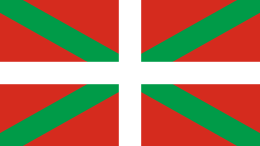Basque parliamentary election, 1986
Basque parliamentary election, 1986

|
|
|
|
All 75 seats in the Basque Parliament
38 seats needed for a majority |
| Registered |
1,660,143  4.8% 4.8% |
| Turnout |
1,155,815 (69.6%)
 1.1 pp 1.1 pp |
| |
First party |
Second party |
Third party |
| |
.jpg) |
.jpg) |
 |
| Leader |
José Antonio Ardanza |
Txiki Benegas |
Iñaki Esnaola |
| Party |
EAJ/PNV |
PSE–PSOE |
HB |
| Leader since |
2 March 1985 |
1977 |
1986 |
| Last election |
32 seats, 41.8% |
19 seats, 23.0% |
11 seats, 14.6% |
| Seats won |
17 |
19 |
13 |
| Seat change |
 15 15 |
±0 |
 2 2 |
| Popular vote |
271,208 |
252,233 |
199,900 |
| Percentage |
23.6% |
22.0% |
17.4% |
| Swing |
 18.2 pp 18.2 pp |
 1.0 pp 1.0 pp |
 2.8 pp 2.8 pp |
|
| |
Fourth party |
Fifth party |
Sixth party |
| |
.jpg) |
 |
 |
| Leader |
Carlos Garaikoetxea |
Juan María Bandrés |
Julen Guimón |
| Party |
EA |
EE |
AP |
| Leader since |
4 September 1986 |
1985 |
1986 |
| Last election |
Did not contest |
6 seats, 7.9% |
7 seats, 9.3%[lower-alpha 1] |
| Seats won |
13 |
9 |
2 |
| Seat change |
 13 13 |
 3 3 |
 5 5 |
| Popular vote |
181,175 |
124,423 |
55,606 |
| Percentage |
15.8% |
10.8% |
4.8% |
| Swing |
New party |
 2.9 pp 2.9 pp |
 4.5 pp 4.5 pp |
|
|
|
The 1986 Basque parliamentary election was held on Sunday, 30 November 1986, to elect the 3rd Basque Parliament, the regional legislature of the Spanish autonomous community of the Basque Country. At stake were all 75 seats in the Parliament, determining the Lehendakari (President of the Basque Country).
The Socialist Party of the Basque Country (PSE-PSOE) won 19 seats, the Basque Nationalist Party (EAJ-PNV) came second with 17 seats, People's Unity (HB) and Basque Solidarity (EA), a PNV split, each won 13 seats, and Basque Country Left won 9 seats.
Electoral system
The 75 members of the Basque Parliament were elected in 3 multi-member districts, corresponding to the Basque Country's three provinces, using the D'Hondt method and a closed-list proportional representation system. Each district was assigned a fixed set of seats, distributed as follows: Alava (25), Biscay (25) and Gipuzkoa (25).
Voting was on the basis of universal suffrage in a secret ballot. Only lists polling above 5% of valid votes in each district (which include blank ballots—for none of the above) were entitled to enter the seat distribution.[1]
Results
Overall
|
Blank ballots |
5,003 | 0.44 | –0.03 |
|
|
| Total |
1,149,035 | 100.00 | |
75 | ±0 |
|
| Valid votes |
1,149,035 | 99.41 | –0.01 |
|
| Invalid votes |
6,780 | 0.59 | +0.01 |
| Votes cast / turnout |
1,155,815 | 69.62 | +1.13 |
| Abstentions |
504,328 | 30.38 | –1.13 |
| Registered voters |
1,660,143 | |
|
| Source: Argos Information Portal |
| |
Results by district
|
| District |
PNV |
PSE |
HB |
EA |
EE |
AP–PL |
CDS |
|
% |
S |
% |
S |
% |
S |
% |
S |
% |
S |
% |
S |
% |
S |
| Álava |
20.1 |
5 |
24.9 |
7 |
10.8 |
3 |
14.5 |
4 |
10.9 |
3 |
6.9 |
1 |
8.0 |
2 |
| Biscay |
28.8 |
8 |
22.5 |
6 |
16.0 |
4 |
11.7 |
3 |
10.2 |
3 |
5.1 |
1 |
3.2 |
– |
| Gipuzkoa |
16.0 |
4 |
19.9 |
6 |
21.6 |
6 |
23.1 |
6 |
11.9 |
3 |
3.6 |
– |
2.4 |
– |
| Total |
23.6 |
17 |
22.0 |
19 |
17.4 |
13 |
15.8 |
13 |
10.8 |
9 |
4.8 |
2 |
3.5 |
2 |
References

.jpg)
.jpg)

.jpg)
